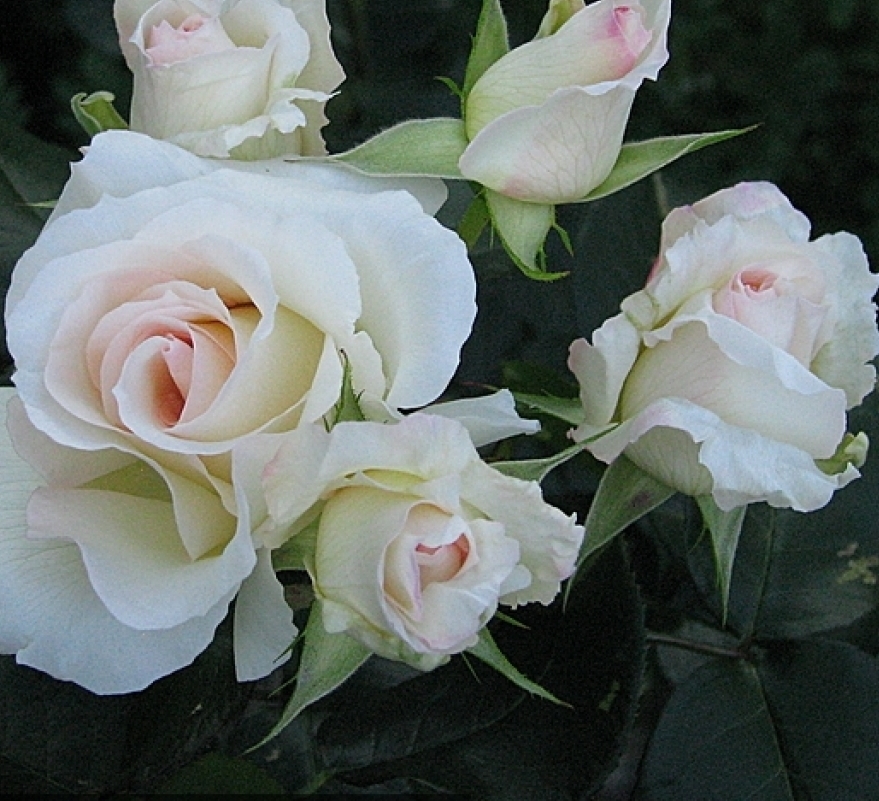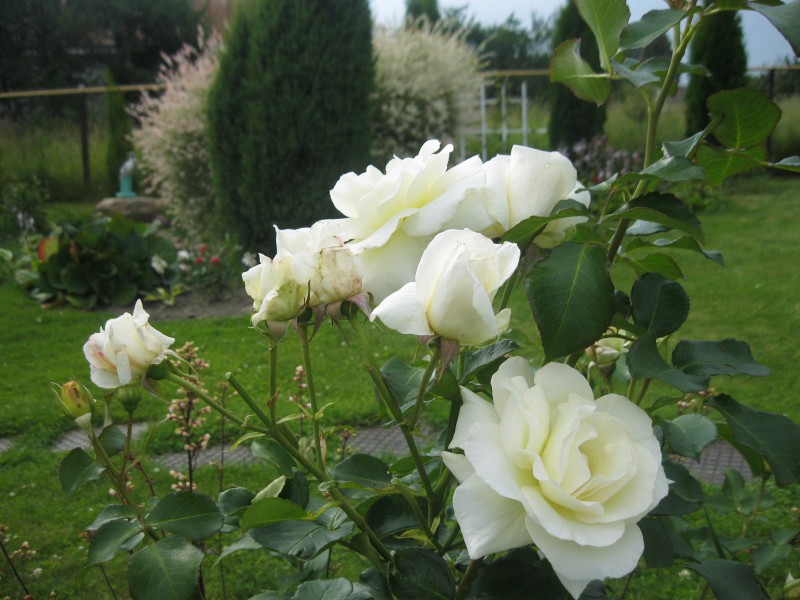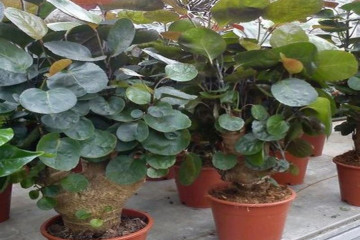Rosa Schneewalzer - characteristics and conditions of care
Content:
Among climbing roses, the Schneewalzer variety stands out for its large snow-white flowers. Literally from German, the name of the plant is translated as "snow waltz". Bred in 1987 by the Tantsu dynasty. A description of the variety and basic information on its care are given below.
Brief description of the variety
The rose is a perennial crop that grows up to 3 m long. The width of the plant can be 2 m. An overgrown adult bush can occupy 2-2.5 m². In shape, the flowers resemble hybrid tea varieties with a size of 14-16 cm. The foliage has a rich green color, the bush very quickly gains green mass.
The flowers of the Schneeweiser rose (also called the Schneewalzer or Schniwalzer) first have a pale lemon tint, then, as the bud opens, they become pure white.
Benefits of the variety
The benefits include the following qualities:
- long and abundant flowering;
- good frost resistance;
- delicate pleasant scent of flowers;
- resistance to most diseases;
- excellent decorative characteristics.
Use in landscape design
The Schneewalzer climbing rose is used most often for landscaping in the vertical design of various areas of the garden. It will perfectly cover an ugly or deformed area on a facade or hedge. The plant can be used to decorate a gazebo or recreation area, and even with it you can create a beautiful arch. A rose bush will adorn any site, it looks harmoniously in any stylistic direction.
Growing a flower
Climbing rose Schneewalzer feels great in an elevated sunny area where it can grow. In the southern regions, it is better to plant the variety in partial shade - where it will receive enough light in the first half of the day, and in the second it will be protected from the effects of scorching sunlight.
Planting is done with seedlings, which should be purchased only in licensed stores and already established nurseries. This is the only way to be sure that the specimen is healthy and has all the varietal qualities of a climbing rose.
Seat selection
The bush grows very much, so it is worth choosing a place for planting so that no other plants grow in diameter 2 m from it and no buildings stand. In this case, the site should not be in a lowland and too shaded place. The area should additionally be well ventilated, then the plant will hurt less.
How to prepare the soil and flower for planting
If the soil is clayey, peat, humus, sand, compost should be added to it before the planting procedure. On the contrary, it is recommended to introduce clay soil into sandy soil, into which you need to add sod soil and peat-manure compost or humus. The acidity of the soil should be below the norm, therefore, if manure or peat is introduced for acidification, and lime or ash is suitable to reduce it.
If the seedling has too long roots or shows damage, it is necessary to cut them off. For a day, the seedling should be placed in a solution of a root growth stimulator. This will promote better root development.
Planting procedure step by step
The Schneewalzer rose is planted at an angle of 30 ° to the support.
The process of planting a rose is as follows:
- A hole of 60 × 60 cm is pre-dug and thoroughly spilled with water.
- A substrate consisting of humus, sand and peat is poured into the prepared pit.
- The seedling is carefully removed from the container, then the dead roots are removed.
- A rose seedling must be installed in a hole, deepening the root collar by three fingers into the soil.
- The roots of the seedling are covered with a fertile substrate, compacted and well spilled with water.
- As soon as the soil settles, it is necessary to fill up the soil to the desired level.
Plant care
Climbing rose Schneewalzer requires special care. It consists in timely watering, loosening, weeding, feeding, pruning excess shoots and preventing diseases.
Watering rules and humidity
The rose bush loves moisture, but does not tolerate stagnant water at all. Water it only when the soil is dry enough. In dry weather, watering is carried out twice a week. One bush requires up to 20 liters of warm water. In August, watering is reduced, and with the onset of autumn, it stops altogether.
Top dressing and soil quality
In the spring, fertilizing is introduced in the form of nitrogenous fertilizers. During the flowering period, they stop, replacing it with one that contains phosphorus and potassium. In August, feeding stops altogether so that the Schneewalzer bush has time to prepare for winter.
It should also be noted that no feeding is applied in the first year. For a rose, the substrate laid in the planting pit is enough. Fertilization starts only next year.
Roses are very demanding on the soil. They need fertile and breathable soil. Moisture and air flow better to the roots if the soil at the planting site is light and loose.
Pruning and replanting
Pruning of the climbing variety is carried out during the entire growing season of the plant. In the spring, frail shoots, the top and those parts that have suffered from frost are removed. In summer, pruning is carried out weak, removing only faded buds. In the fall, they get rid of sick and damaged shoots, and also thin out overgrown bushes. Such pruning is also called sanitary.
Features of wintering a flower
Depending on the region of planting roses, they begin to cover it in October-November. To do this, press all the lashes with arcs to the ground, and then lay the covering material on top. Even in Siberia, the Schneewalzer rose can winter well if there is a thick snow cover. But it is imperative to cover the bush for the winter.
Blooming rose
Under the weight of large snow-white flowers, rose bushes begin to hang down, which makes them visually even more fragile and delicate. Passing blooming roses, you get the feeling that at this moment you are in the gallery. They look like they are made of crystal. Their extraordinary beauty immediately attracts the eye.
A period of activity and rest
Climbing rose Schneewalzer belongs to the multi-flowering species. She especially pleases with an abundance of flowers during the first wave. After it, the second does not come immediately. Individual flowers may appear in between. The rose blooms from late June to late August.
Care during and after flowering
In the first year after planting, do not allow the rose to bloom. The buds must be removed, leaving only 1-2 flowers on the shoot. Regulate the number of buds until August.
What to do if it does not bloom
There are many reasons why a rose does not bloom. Most often, improper care leads to the following consequences: from improper watering to untimely pruning. Top dressing at the wrong time and an overly shaded area are the key reasons for the lack of flowers. But in any case, you must first understand the reason, then proceed to eliminate it.
Flower propagation
Rose Schneewalzer propagates only by cuttings. Exclusively this method allows you to preserve all the varietal qualities of the mother bush.
Strong and not old bushes are suitable for harvesting cuttings. Cut off the branches after the first wave of flowering ends.
It is necessary to cut a climbing rose Schneewalzer as follows:
- Shoots with a thickness of 5 mm are selected.
- The required amount is cut off so that each stalk has about five buds. In this case, the upper cut is made straight and 2 cm above the upper kidney, the lower slanting immediately below the first eye.
- Cuttings should be treated with a root former. If the rooting of the plant is supposed to be done immediately, it is not required to cut off the leaves.
- A hole is dug 30 cm deep, then it is filled with grass and compost.
- The shoot should be planted at a 45 ° angle so that the cutting remains 1/3 above the surface.
- Further care consists in abundant watering.
- By winter, the shoots must be covered under the dome and covered with a covering material.
Diseases, pests and ways to control them
The Schneewalzer rose variety is quite resistant to various diseases. If the planting site is chosen correctly and the plant is properly cared for, the climbing rose will not have problems with diseases. For prophylaxis, the rose should be treated with Bordeaux liquid in the spring.
The Schneewalzer rose will be a wonderful decoration for any garden. You just need to give it a little more space. Following the rules of agricultural technology will allow you to get abundant flowering already in the second year after planting the plant in open ground.




















